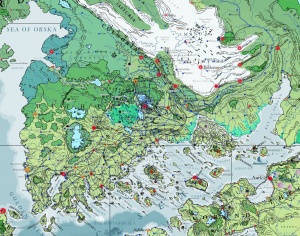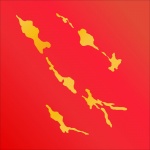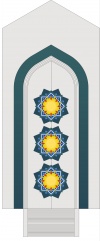Difference between revisions of "Main Page"
Trismegistus (talk | contribs) m |
Trismegistus (talk | contribs) (New Article Links) |
||
| Line 39: | Line 39: | ||
| style="color:#000;" | <div id="mp-tfa" style="padding:2px 5px"> | | style="color:#000;" | <div id="mp-tfa" style="padding:2px 5px"> | ||
| − | [[File: | + | [[File:Pytharnia_2750_001.jpg|thumb|300px|Map of Pytharnia]] |
| − | + | The southern land of the continent of [[Pytharniaca]] is usually called Pytharnia, leaving the scientific term 'Pytharniaca' to those who wish to refer strictly to the whole land mass. In its commonly used sense, Pytharnia refers to the southern half settled by humans. In origin, Pytharnia originally meant the hilly lands between the [[Mathgefrew Mountains]] of the south and the dense woodlands of the north. The core territory of the [[Empire of Magdala]] or 'The [[Magdalanate]]' rests on the [[Pytharnian Highlands]]. Scholars do not have a wide consensus on the origin of the name 'Pytharnia.' Some believe it originates from the name of ancient dragons. ([[Pytharnia|Full Article]]...) | |
| − | + | Pytharnia in its broadest geographic sense as [[Pytharniaca]] is a subcontinent that has been slowly merging into the much greater continent of Asdauria for eons, forming the world-famous Jaggudorns, the highest mountains in the known world and probably the whole world. Riddled with ancient tribes and languages, Pytharnia is home to humans, elves, dwarves, halflings, gnomes, beastmen, trolls, and many more creatures. Nestled in the high foothills of the southwestern Jaggudorns are found four dwarven states. The [[Amandal Plateau]] is home to another dwarven state, Amandalia, where mystical dwarves have communed with the infinite for eternity. [[Sardeichs]] is the smallest and the most economically driven of these dwarven micro-empires. Although this smallest of the dwarven states is well in the [[Jaggudorn Mountains|Jaggudorns]], its commerce and outlook is towards Pytharnia and the [[Pallathantic Sea]]. | |
| − | |||
| − | |||
|- | |- | ||
| Line 52: | Line 50: | ||
| style="color:#000; padding:2px 5px 5px;" | <div id="mp-dyk"> | | style="color:#000; padding:2px 5px 5px;" | <div id="mp-dyk"> | ||
| − | * Did you know that the [[ | + | * Did you know that the [[Jaggudorn Mountains]] are roughly the same elevation as the Himalayas but lie farther north and were the homeland of the ancient [[Gwenyan Tribes of the High Shadevan Valley|Sky Tribes]]? |
| + | |||
| + | * Did you know that [[Omandral Sorcerer King]] was born of a [[Medibgösk]] father and a [[Jerushabla]]n mother, converted to the [[Imzaha]] religion, and established the short-lived [[Omandraline Empire of Sky]]? | ||
| + | |||
| + | * Did you know that [[Neptultchi Language]] is not related to any [[Gwenyan Language]] or indeed to any known language other than its child languages, [[Tuadbean Language|Tuadbe]] and [[Xsyte Language|Xsyte]]? | ||
| − | * Did you know that [[ | + | * Did you know that the [[Durrhaunvian Triad]] is a group of three sister goddesses, [[Dáunau]], [[Devahlia]], and [[Dasironessa]], traditionally worshiped in the [[Durrhaunve]] Valley? |
| − | * Did you know that [[ | + | * Did you know that the principle officers and organs of the government of the [[Republic of Johaulia]] are the [[Meddix (Johaulia)|Johaulia]], the [[Cobalt College]], and the [[Senate of Johaulia|Senate]]? |
| − | * Did you know that [[ | + | * Did you know that the [[Drakeling]] is a domesticated dragon ridden by [[Dragon Knights]] in southern [[Pytharnia]] for possibly as much as seven thousand years? |
| − | * Did you know that | + | * Did you know that [[Erechórebese Sunfather]] [[Orry II]] promoted and sponsored the [[Congress of Bryndyd]] in 2587 to resolve lingering issues of treaty and policy in the years after the [[Great Sky War]] and the [[Fifth Geddamin War]]? |
| − | * Did you know | + | * Did you know that the ancient [[Jairutthalese Empire]] of [[Kalama]] predated the [[City-State Period of Kalama]] and thus is generally considered mythical? |
</div> | </div> | ||
| Line 74: | Line 76: | ||
| style="padding:2px;" | <h2 id="mp-itn-h2" style="margin:3px; background:#cedff2; font-size:120%; font-weight:bold; border:1px solid #a3b0bf; text-align:left; color:#000; padding:0.2em 0.4em;">Featured Pictures </h2> | | style="padding:2px;" | <h2 id="mp-itn-h2" style="margin:3px; background:#cedff2; font-size:120%; font-weight:bold; border:1px solid #a3b0bf; text-align:left; color:#000; padding:0.2em 0.4em;">Featured Pictures </h2> | ||
|- | |- | ||
| − | | style="color:#000; padding:2px 5px;" | <div id="mp-itn"> [[File: | + | | style="color:#000; padding:2px 5px;" | <div id="mp-itn"> [[File:ColorImridsulDye.jpg|left|thumb|150px|Artist's depiction of the color produced by the dye [[Imridsul]] ]] |
| − | The | + | Imridsul is a very costly dye made from the eggs of the deepearth-dwelling Thrystonese basilisk through a process that requires nearly two years (about 28 common months). The color imridsul is an intense crimson with brilliant streaks and splotches that sparkle like metallic gold. Garments made from cloths dyed this color are some of the most desirable in the world. The dye is extraordinarily color fast and does not fade even after many years. The effect is considered impossible to duplicate, but has stimulated a market for gold-embroidered crimson clothes which although costly are not as fantastically costly as cloths dyed in imridsul. In ancient times, the sale and use of the dye was strictly regulated by kings and its use reserved for aristocrats and royals. Even a small component of one's costume dyed in imridsul was a strong status symbol. ([[Imridsul|Full Article]]...) |
| − | [[File: | + | [[File:YophentheanGatesofWallsofTrevirs.jpg|left|thumb|100px|Yophenthean Gates of the Walls of [[Trevirs]] ]] |
| − | The | + | The Yophenthean Gates of the Walls of [[Trevirs]] are over two thousand years old. Trevirs is the most populous human city in the Pallathantic Region with 960,000 inhabitants, the fourth most populous in the old world, and heir to a past reaching back into the mists of human history. Trevirs rests atop a large prominence of hills in the Magdanalate of the Empire of Magdala. The Palace of the Imperial Diet rests in Trevirs. Historically, Trevirs was also the place of the Imperial Palace. The city is sometimes called Great Trevirs to distinguish it expressly from Royal Trevirs. Trevirs arose in very ancient times as a Pytharnian Giant settlement and eventually came under control of various human tribes. Since the Fall of the Yophenthean Empire, Trevirs has served as an important skyport between the western Jaggudorns, Medibgö, and the Pallathantic Region. Trevirs is the financial capital of southeastern Pytharnia and the seat of the headquarters of several important organizations including the Dwarven Dragonrail Guild of Pytharnia and the Sovereign Archguild of Master Titancrafters of Pytharnia. Trevirs remains the seat of the Palace of the Imperial Diet of Magdala. ([[Trevirs|Full Article]]...) |
</div> | </div> | ||
| Line 108: | Line 110: | ||
|- | |- | ||
| style="color:#000;" | <div id="mp-middle" style="padding:2px 5px"> | | style="color:#000;" | <div id="mp-middle" style="padding:2px 5px"> | ||
| − | The | + | {{icon|arathracianism}} The Erechórebese [[Arathracian Religion]] honors the [[Erechórebese Sunfather]] as the highest earthly authority of the ecumenical church. There has been a sunfather with two major periods of absence since the [[Fall of the Yophenthean Empire]]. The complete [[List of Erechórebese Sunfathers|list of Erechórebese Sunfathers]] gives their reigns and occasionally a remark about their accomplishments in the [[Erechórebese Arathracian Church]]. ([[List of Erechórebese Sunfathers|See Full Article]]...) |
</div> | </div> | ||
Revision as of 02:47, 21 January 2015
|
|
|
|
Other Resources
- World of Asdar Main Homepage This page is very minimal (2014 May 17)
- World of Asdar Blog begun 2014 May 17
- Random Article
- Gallery of New Files
- Utility Page



